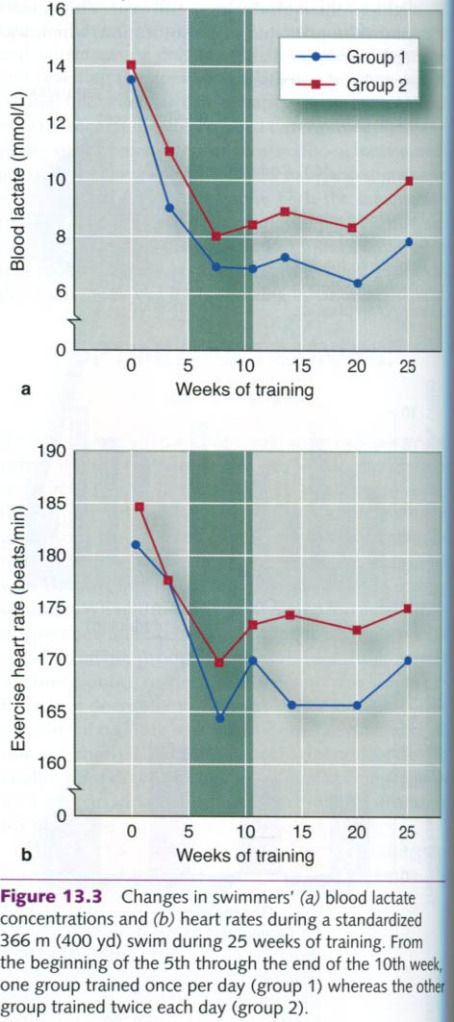Most of the research on excessive training has
been conducted on swimmers. For that reason, the material in this section
concerns swimmers, but it alos applies to most other forms of training.
One can increase training volume by increasing
either the duration or the frequency of training bouts. But does increased
volume translate into increased performance? Research shows that swim training
3 to 4h per day, five or six days each week, provides no greater benefits than
training only 1 to 1.5h per day. In fact, such excessive training has been
shown to significantly decrease muscular strength and sprint swimming
performance.
Few studies have compared the physical conditioning
and performance benefits of single versus multiple daily training sessions.
Studies conducted thus far reveal no scientific evidence that multiple daily
training sessions enhance fitness and performance more than a single daily
session. This is illustrated in the picture below, which show the responses of
two groups of swimmers who trained once per day(group 1) or twice per day(group
2) for a period of six weeks during a 25-week training program. All swimmers
began the program following the same training regimen: one time per day. But
from the beginning of the 5th week through the end of the 10th
week, group 2 increased its training to twice per day. After six weeks on the
different regimens, both groups returned to once-daily program. All the swimmers’
heart rates and blood lactate values decreased dramatically when training began,
and no significant differences were seen in the two groups’ results in response
to the change in training volume. The swimmers who trained twice per day showed
no additional improvements over those who trained only once per day. In fact,
their blood lactate
concentrations(figure a) and heart rates(figure
b) appeared to be slightly higher for same fixed-pace swim.
To determine the influence of long-term,
excessive training, performance improvements of swimmers who trained twice
daily for a total distance of more than 10,000m(10,936yd) per day(the LS, or
long-swim group) were compared with improvements of those who swam
approximately half that distance in a single session each day(SS, or
short-swim, group). Changes in performance time for the 100yd(91m) front crawl
were examined over a four-year period for both groups. The LS swimmers and SS
swimmers experienced an identical average improvement of 0,8% per year. Similar
findings also were observed for competitors in other events, such as the 200,
500, and 1,650yd(183, 457, and 1,509m) front crawl.
The concept of training specificity implies
that several hours of daily training will not provide the adaptations needed
for athletes who participate in events of short duration. Most competitive
swimming events last less than 2 min. How can training for 3 to 4h per day at
speeds that are markedly slower than competitive pace prepare the swimmer for
the maximal efforts of competition? Such a large training volume prepares the
athlete to tolerate a high volume of training but likely does little to benefit
actual performance.
The need for long daily workouts(high volume)
is now being seriously questioned by researchers. For certain sports, it
appears that training volume could be reduced significantly, possibly by as
much as one-half in some sports, without reducing the benefits, and with less
risk of overtraining athletes to the point of decreased performance. The
principle of training specificity suggests that low-intensity, high-volume
training does not improve sprint-type performance.
Training intensity is also an important factor
and refers to both the relative force of muscle action(i.e., resistance
training) and the relative stress placed on the metabolic and cardiovascular system(i.e., anaerobic and aerobic training). There is a strong interaction between training
intensity and training volume: as intensity is reduced, training volume must be
increased to achieve adaptation. Training at very high intensities requires
substantially less training volume, but the adaptation that occur will be
significantly different from those achieved with low-intensity, high-volume
training. This concept applies to all three types of training, that is,
resistance, anaerobic and aerobic.
High-intensity, low-volume training can be
tolerated only for brief periods. While this type of training does increase
muscular strength in resistance training and total body speed and anaerobic capacity in high-intensity
interval training, it provides little or no improvement in aerobic capacity. Conversely, low-intensity, high-volume training
stresses the oxygen transport and oxidative metabolic systems, causing greater
gains in aerobic capacity, but has
little or no effect on muscular strength, anaerobic capacity, or total body speed.
Attempts to perform large amounts of
high-intensity training can have negative effects on adaptation. The energy
needs of high-intensity exercise place greater demands on the glycolytic system, rapidly depleting muscle glycogen. If such training is
attempted too often, for example daily, the muscles can become chronically
depleted of their energy reserves, and the person might demonstrate signs of chronic fatique or overtraining.










0 коментара:
Постави коментар